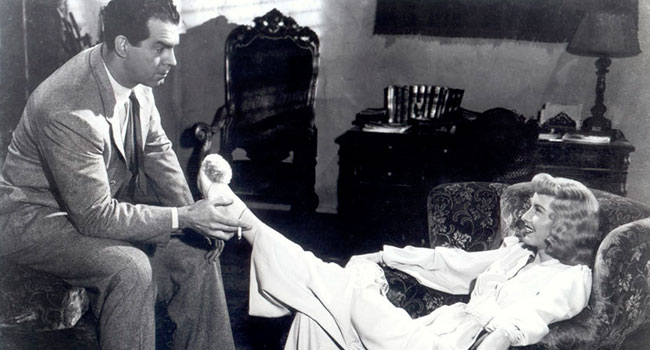 Double Indemnity was released to theatres in 1944 – the year I was born. So I missed it the first time around.
Double Indemnity was released to theatres in 1944 – the year I was born. So I missed it the first time around.
And while it’s been on TV on and off over the ensuing decades, I only saw snippets and thus didn’t appreciate what the fuss was about. Then I caught the whole thing last weekend and have seen the light.
It’s a terrific movie, a real cracker. If you’ve never seen it, do yourself a favour.
Double Indemnity has been hailed as “the first fully developed example” of film noir. Whether noir is a genre, a sub-genre, a mood or a visual style is a matter of some debate among those who like arguing about such things.
Maybe the easiest way to think of noir is in terms of characteristics.
Some of these relate to the technical aspects of the filmmaker’s trade. Black and white photography, urban settings, atmospheric lighting and lots of shadows are prime elements. And voice-over narration often makes an appearance.
Other noir characteristics have to do with theme and feel.
Characters – even heroes – tend to be cynical and morally ambiguous. Corruption is rife and there’s no safe space for the naïve or the credulous. The noir world isn’t a beautiful place.
As for literary source material, it’ll come from someone like Dashiell Hammett rather than Agatha Christie. And the emotional ambience will be hard-boiled, not cosy.
Double Indemnity’s plot revolves around an insurance salesman (Fred MacMurray) and a dissatisfied wife (Barbara Stanwyck) plotting to kill her husband in order to pocket the proceeds of an insurance policy. But things get complicated after the murder. A veteran claims manager (Edward G. Robinson) smells a rat and the meticulously constructed edifice starts to crumble.
Co-written by director Billy Wilder and mystery novelist Raymond Chandler, the movie’s tension builds and the dialogue crackles. Drama critic Terry Teachout describes the script as “a dazzling amalgam of precisely tooled plot points and sharp-cornered repartee.” That’s no exaggeration.
And we’re reminded of how tobacco once served as an effective cinematic prop. A recurring bit of business using thumb-flicked matches to light cigarettes and cigars underlines how casual physical actions can be visually arresting.
All three main players deliver the goods.
MacMurray, however, wasn’t Wilder’s first choice to play the crooked salesman. Neither was he particularly receptive to the offer.
Hitherto mostly known for light, good-guy roles, he was unsure whether he had the requisite acting chops. But he eventually agreed and subsequently came to regard it as his very favourite role in a lucrative career spanning almost 50 years.
Stanwyck was a New Yorker who had risen to become America’s highest-paid woman. She was an accomplished actress, excelling in drama and comedy, and already had two Oscar nominations under her belt – for the title role in Stella Dallas (1937) and the part of Sugarpuss O’Shea in Ball of Fire (1941).
Although first choice for her role, Stanwyck, too, was initially reluctant. Unlike in MacMurray’s case, the wariness had nothing to do with doubting her ability. Instead, she was “a little afraid after all these years of playing heroines to go into an out-and-out killer.”
Then, having taken the plunge, she projected a portrait of calculated, erotically-charged villainy. It snagged her a third Oscar nomination.
Commentary on the relationship between the MacMurray and Stanwyck characters often depicts him as a relative innocent led astray by a conniving femme fatale.
That’s not how I experienced it.
Yes, MacMurray comes across as the weaker of the two. But driven by a combination of lust and greed, he’s not exactly reluctant.
For Robinson, Double Indemnity marked a step down to third lead. He didn’t particularly like the idea but, having passed 50, he’d come to terms with the fact that supporting roles were now increasingly likely.
And what a role!
To me, Robinson is the best thing in a movie filled with strong performances.
Double Indemnity is a throwback to a time when Hollywood was much more politically diverse than it is today. All four principals were outspoken activists, albeit not of the same persuasion.
MacMurray and Stanwyck were conservative Republicans while Robinson and Wilder were liberal Democrats. That, however, didn’t prevent them from working together and respecting each other’s talents.
The era of cancel culture hadn’t yet arrived.
Troy Media columnist Pat Murphy casts a history buff’s eye at the goings-on in our world. Never cynical – well, perhaps just a little bit.
The views, opinions and positions expressed by columnists and contributors are the author’s alone. They do not inherently or expressly reflect the views, opinions and/or positions of our publication.


